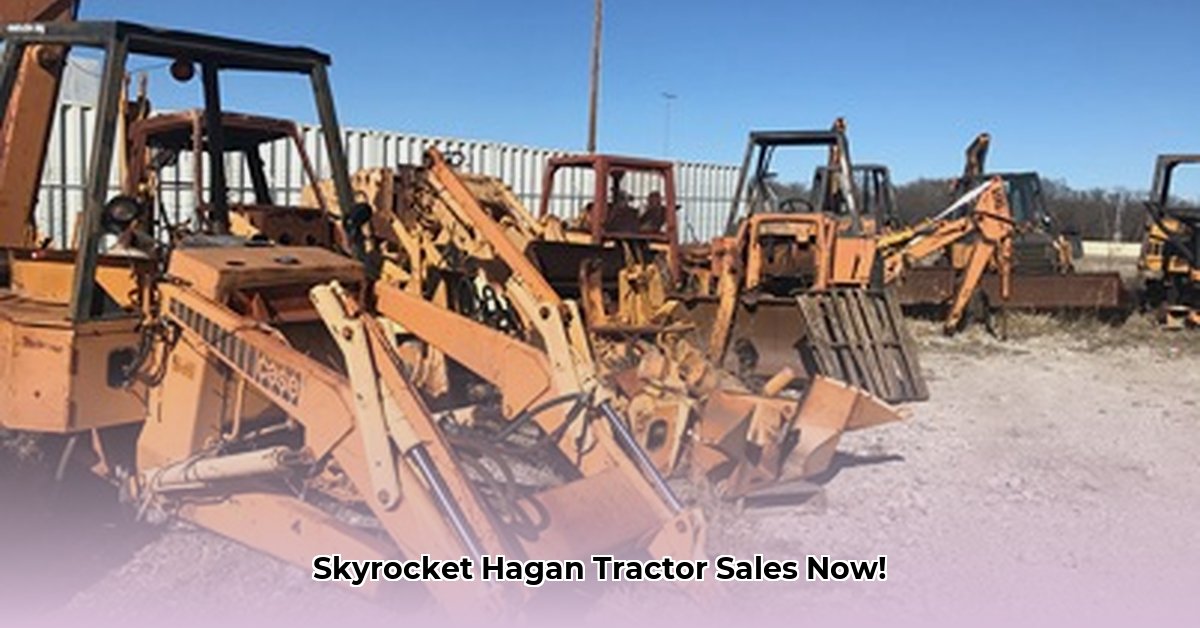
Hagan Tractor: A Comprehensive Growth Strategy
Hagan Tractor, encompassing Hagan Tractor Parts and Hagan's Outdoor Equipment, operates a vertically integrated model, showcasing significant potential for growth. This analysis identifies key strengths and weaknesses, proposes actionable strategies, and outlines a roadmap for enhanced sales and market expansion. We will explore both short-term actionable improvements and long-term strategic goals to ensure sustainable success. For sellers, consider exploring options like this resource.
Hagan Tractor Parts: Strengthening the Foundation
Hagan Tractor Parts, specializing in Case parts and remanufacturing, possesses a robust inventory and deep expertise. However, its regional focus and limited online presence hinder broader market penetration. This represents a significant missed opportunity in today's digital age. What percentage of potential customers are they missing due to limited online reach? This requires immediate attention.
Strengths:
- Deep Case Expertise: Unmatched knowledge and experience in Case parts repair and maintenance.
- Remanufacturing Prowess: Cost-effective and environmentally conscious approach to parts management, resulting in a 99% parts salvage rate. This is a competitive advantage that should be prominently featured in marketing materials.
- Extensive Inventory: A large stock readily available for quick order fulfillment, ensuring customer satisfaction and reducing lead times.
Weaknesses:
- Limited Online Presence: A poorly optimized website severely restricts reach and limits customer acquisition.
- Regional Focus: Restricts market share and potential revenue growth.
- Potential Inventory Inefficiencies: Without a robust inventory management system, overstocking and obsolescence may impact profitability.
Hagan's Outdoor Equipment: Cultivating Customer Loyalty
Hagan's Outdoor Equipment, with its Kubota focus, prioritizes customer relationships. This builds loyalty and repeat business. Despite having a strong foundation, further growth relies on expansion and enhanced marketing. How can a customer-centric approach be leveraged further to drive sales? A strategic approach will be key here.
Strengths:
- Customer-Centric Approach: Cultivating strong customer relationships fosters loyalty and repeat business.
- Kubota Specialization: A clear market focus creates brand identity and expertise.
- Potential for Bundled Services: Offering package deals could enhance customer value and increase average transaction values.
Weaknesses:
- Need for Enhanced Marketing: Insufficient marketing hinders customer awareness and limits potential market reach.
- Limited Product Diversification: Over-reliance on Kubota limits potential growth opportunities. Exploring new partnerships could be beneficial.
Market Analysis: Navigating the Competitive Landscape
The agricultural equipment market is highly competitive. Hagan needs a clear differentiation strategy to succeed against larger players. Focusing on niche markets, superior customer service, and technological innovation are critical for success.
Actionable Strategies: A Roadmap for Growth
This section details a comprehensive growth strategy incorporating short-term and long-term goals.
Phase 1: Short-Term Actions (Within 1 Year)
Website Overhaul: A modern, user-friendly website with e-commerce capabilities is crucial. High-quality images, detailed descriptions, secure payment gateways, and intuitive navigation are essential. This will directly impact online sales.
Targeted Digital Marketing: Invest in SEO and targeted paid advertising (Google Ads) to reach potential customers. Use social media strategically to engage with the target audience.
Customer Relationship Management (CRM) System: Utilize a CRM to track customer interactions, personalize communication, and optimize marketing efforts. This will improve customer loyalty and generate repeat business.
Inventory Optimization: Implement an inventory management system to streamline operations, minimize waste, and accurately forecast demand. This will improve efficiency and reduce unnecessary costs.
Strategic Partnerships: Explore collaborations with complementary businesses to expand product offerings and reach new customers.
Phase 2: Long-Term Actions (3-5 Years)
Geographic Expansion: Carefully planned expansion into new regions will broaden market access and increase potential customer base.
Service Diversification: Expand services to encompass a wider range of brands and equipment, requiring employee training and potential new equipment acquisition.
Advanced E-commerce Platform: Develop a robust platform with features like live inventory updates, advanced search filters, and integrated customer support.
Unified Branding: A unified brand strategy for both divisions will strengthen brand recognition and market positioning.
Explore Adjacent Markets: Consider offering equipment rental or leasing to diversify revenue streams and attract new client segments.
Technological Adoption: Investing in advanced diagnostic tools and technology demonstrates commitment to modernization and enhances service capabilities.
Mitigating Potential Risks
Growth entails inherent risks. The following table outlines potential risks and mitigation strategies:
| Risk Factor | Likelihood | Impact | Mitigation Strategy |
|---|---|---|---|
| Intense Competition | High | High | Niche specialization, exceptional customer service, unique service offerings. |
| Economic Slowdown | Medium | High | Diversified revenue streams, strong customer relationships, cost control. |
| Supply Chain Issues | Medium | Medium | Diversified suppliers, strong supplier relationships, robust inventory management. |
| Technological Change | Medium | Medium | Continuous employee training, planned technological upgrades. |
| Regulatory Changes | Low | Medium | Continuous monitoring of regulations and proactive compliance. |
Conclusion
Hagan Tractor possesses substantial potential for growth. By implementing the outlined strategies and proactively managing risks, Hagan can significantly increase sales and solidify its position as a market leader in the agricultural equipment sector. The path to success lies in embracing digital transformation, optimizing operations, and fostering strong customer relationships.